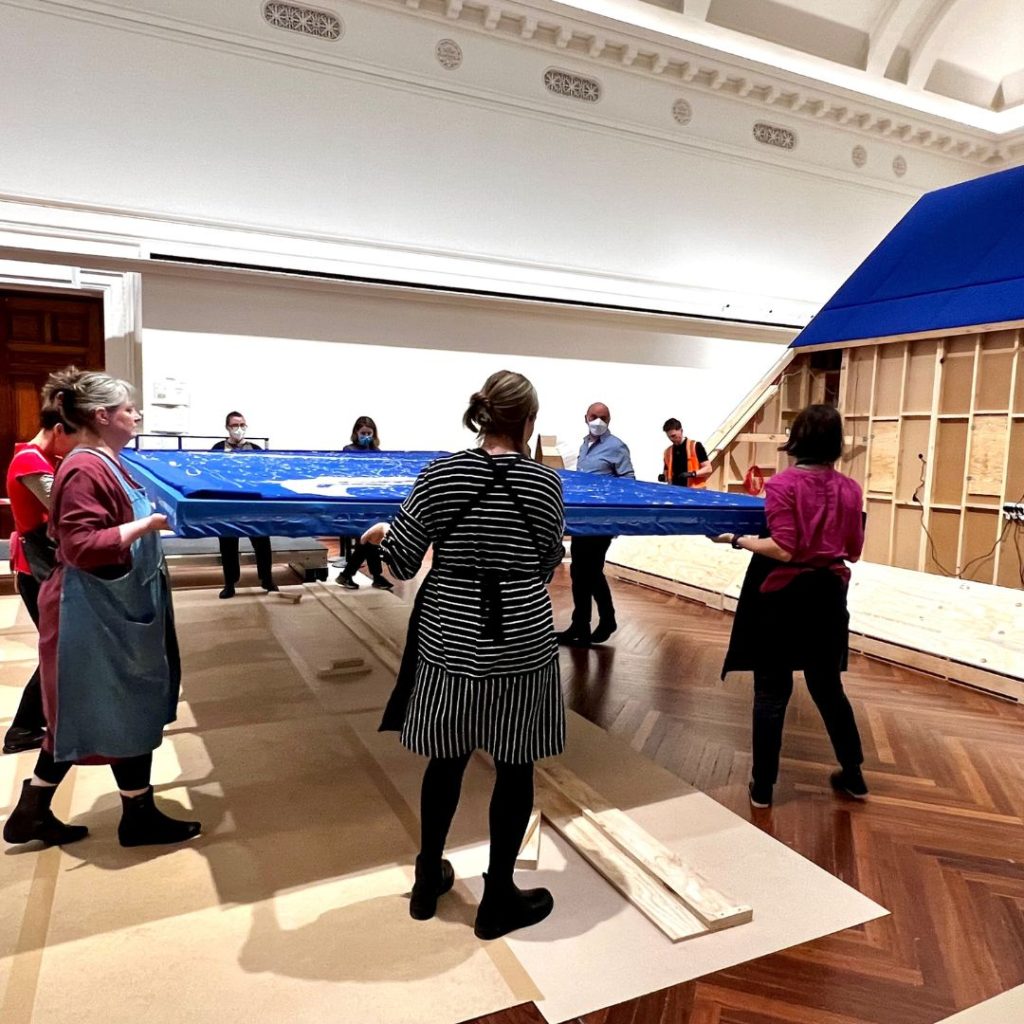
About the team:
State Library Victoria’s Collection Care team lead a wide range of programs and activities designed to ensure the long-term preservation and access of the State Collection.
Collection Care staff work across four main specialist areas: Preventive Conservation, Preservation and Processing, Conservation and Registration.
Preservation is responsible for a wide range of collection rehousing projects, assessment and preparation of material for digitisation, and the identification and management of at-risk formats.
Preservation also manages a suite of Preventive Conservation programs designed to reduce the risk of deterioration and damage to the collection, including disaster response and recovery, environmental monitoring, quarantine and pest control.
Conservation is responsible for the treatment and preparation of collections for exhibition, digitisation and loan, as well as treatment and housing of priority collections. Our team of Conservators specialise in paper, photographic and book conservation. Conservators also work collaboratively with our Exhibitions team to ensure the safety of collection on display.
The small but mighty Registration team manages the Library’s inward and outward loans program, promoting and enabling alternative contexts for collection on display and wider community access.
In addition to the above core activities, Collection Care staff are committed to:
- Researching materials, methods, techniques, and their application
- The development of sustainable work practices
- Supporting programming and exhibitions, membership, donor, and philanthropic activities
- Providing specialist expertise and training to internal and external stakeholders, and…
- Promoting the Library and collections through online platforms, such as this blog!
About the series:
In this blog, Collection Care staff provide insights into their day-to-day work, from archival storage and the proper use of gloves, to potentially hazardous collections and the beauty of Japanese papers and tools.
Curious about the effects of light or the stories behind old repairs? Ever wondered why old books and documents yellow over time? Keen for a peek behind the scenes of our exhibitions program?
Enjoy part one of the series, covering letters A-L and stay tuned for part two!
Archival packaging:


Archival is a well-used term for State Library Victoria’s Collection Care team, especially when it comes to describing the myriad of boxes, enclosures, boards, papers, sleeves and supports they use to preserve and protect the Library collection.
The Collection Care team use a wide range of standard and bespoke archival packaging methods to ensure a long, stable shelf life for all types of materials – from the large and robust, to the small and fragile.
To be considered archival, packaging is tested to ensure it is:
- Resistant to deterioration
- Chemically stable
- Acid-free
- Durable
While inert papers, boards and plastics are also used for a variety of formats, what is appropriate for one medium, may not be suitable for another!
By using appropriate archival packaging materials, we’re ensuring the Library’s extraordinary collection is preserved for many years to come.
Author credit: Kate Holloway, Preservation Manager
Book Cradles:
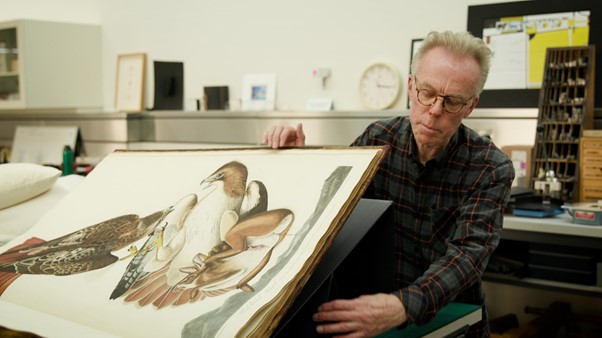
State Library Victoria display over 300 books each year and the Collection Care team work hard to ensure there’s a safe and sturdy support for each and every one of them.
Carefully engineered to mitigate stress and strain on bindings, book cradles are tailored to each book’s size and shape – ensuring titles are safely supported through Library exhibitions, public viewing and periods of display.
The internal support of a book cradle is crafted with polypropylene flute board. This is a preferred material for its flexibility, strength, durability and light weight qualities. A card ‘fence’ is then neatly fashioned around the outside, finishing the cradle off.
The Collection Care team use recyclable materials to cradle the Library’s books. These are often bundled in the Conservation lab, ready to be dismantled and repurposed post-exhibition.
Author credit: Bonnie Hearn, Conservator, Books
Condition:

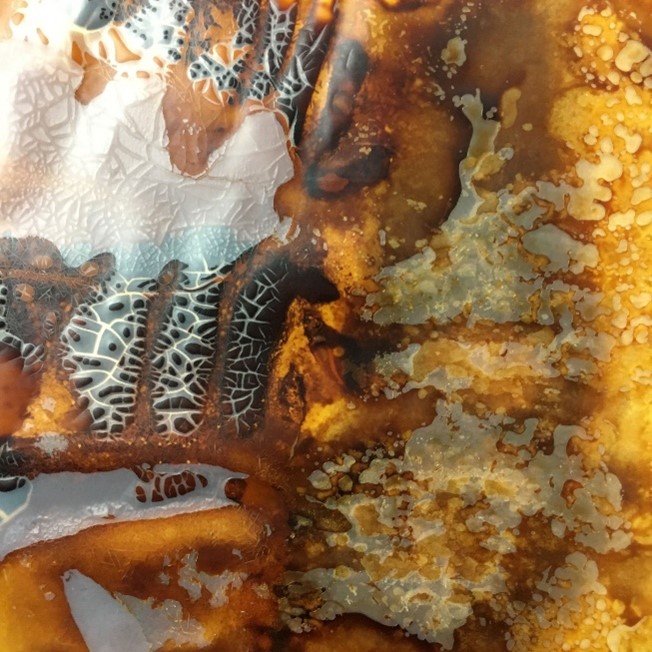
State Library Victoria’s Collection Care team concentrate on conserving the Library’s considerable and curious collections – from clothes and cutlery, to cartoons and correspondence.
To carry out this care, they must first consider an item’s condition.
The Collection Care team are proud custodians of collections that may be crushed, chewed, charred, crumpled, or colonised by creepy-crawlies like clothes moths, carpet beetles or even conidium (mould)!
It is Collection Care’s calling to:
- Consider each cut, crack, crease, chip and curl.
- Classify the condition – be it complex, chronic, catalytic or cumulative.
- Clarify the cause – be it carelessness, callousness, contact with contaminants or calamity.
The team can then categorise and chronicle any concerns, communicate concepts, consult and collaborate.
How else could they coordinate the critical care that our collections have come to count on?
As you can likely comprehend, the Collection Care team are crazy about condition!
Author credit: Albertine Hamilton, Conservator, Paper
Disasters:

State Library Victoria’s Collection Care team protect the Library’s collections from all manner of unexpected incidents.
As part of the Library’s Collection Emergency Response and Recovery Program, the team respond to disasters, carry out appropriate salvage procedures and maintain disaster response equipment and supplies.
The Library’s Disaster Store is stocked with everything one might need to tackle the results of a burst sprinkler head or overflowing downpipe.
Bright yellow disaster bins are also deployed across the Library for quick access to essentials.
As disasters can take many forms, Collection Care prepare for large-scale threats such as fire and flood but are also poised to respond to commonplace disasters.
Over the past two years, Australia has experienced devastating bushfires, a global pandemic and even an earthquake. These events have further highlighted that preparation is key to reducing the risk of damage to precious items and people.
Good planning, an effective reporting structure and regular training are critical to the success of the Library’s Collection Emergency Response and Recovery Program.
Rest assured, the Library collection is in safe hands!
Author credit: Leah Williams, Preservation Technician
Environment:
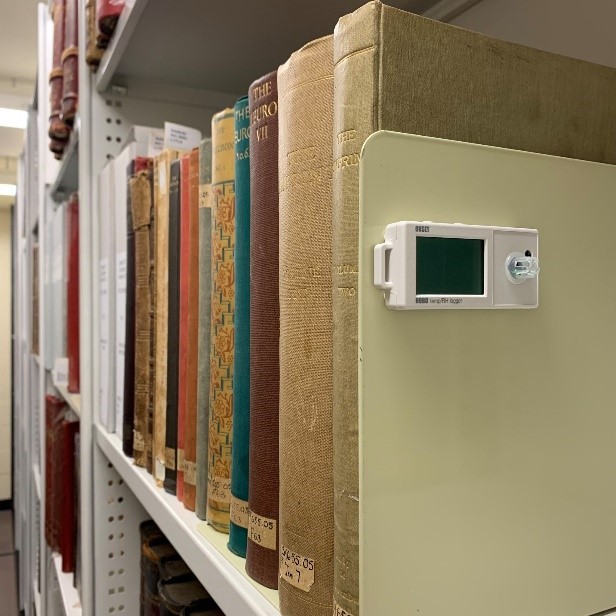
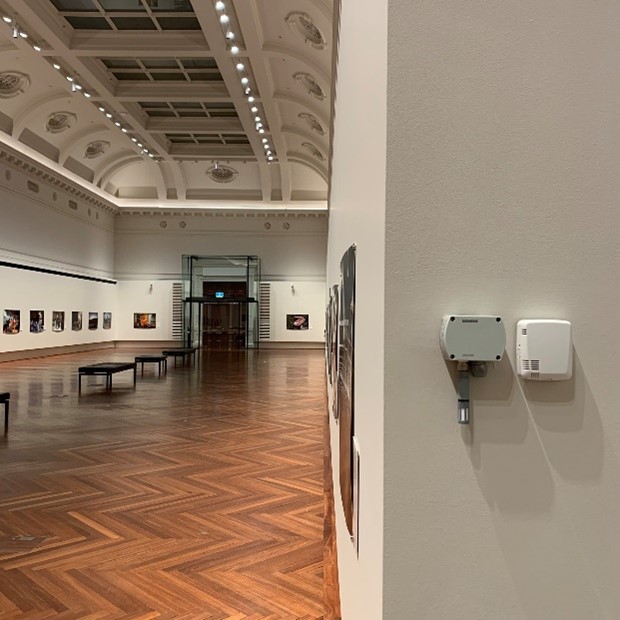
Do you have a preferred climate or a favourite season? The Library’s collections are no different.
Adverse conditions, such as high temperature and relative humidity, contribute significantly to the deterioration rate of collection materials.
Low relative humidity can cause embrittlement and desiccation, while high relative humidity can lead to mould growth and encourage pest activity.
Some of our more vulnerable photographic formats prefer to ‘hibernate’ and are best stored in dry, stable, cool or cold storage for their long-term preservation.
Fluctuating conditions are particularly problematic. Much of the Library’s collection is hygroscopic in nature, readily absorbing and releasing moisture in response to changes in relative humidity. This can lead to flaking ink, warped covers on books and cracked emulsion on photographs.
To ensure recommended conditions are maintained, the Library’s Collection Care team undertake independent environmental monitoring across thirty-four collection stores and seven exhibition spaces.
Environmental data is used to identify both short and long-term risks to the collection. 24-hour access to live data, using wireless and cloud-based technology, ensures any issues are rectified promptly.
While the environment is not something you can see, ensuring appropriate conditions are maintained is vital to the long-term preservation of Victoria’s extraordinary collections.
Author credit: Leah Williams, Preservation Technician
Freezing:
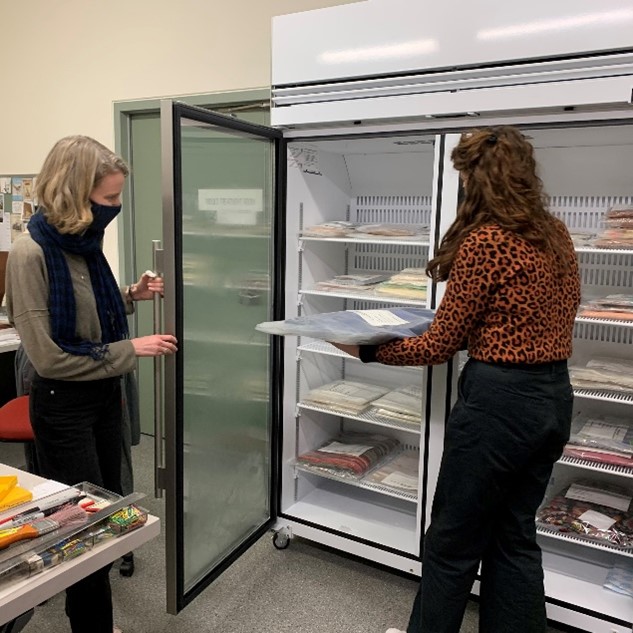
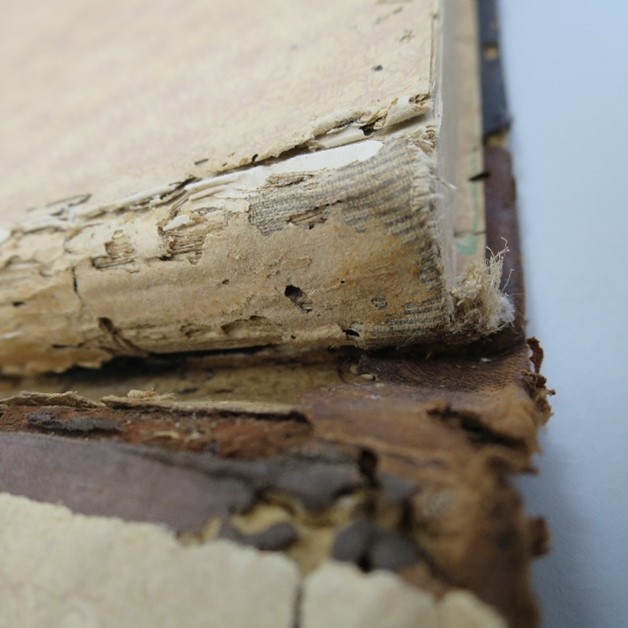
As the weather changes, you may notice more creepy crawlies flying about. Insect activity flourishes during the warmer months as critters emerge from their winter resting phase, looking for food, mates and fun.
Many insect species, such as silverfish, webbing clothes moths and carpet beetles like to feast on organic materials – laying their eggs and making a tasty meal of the cellulose, proteins and starches found in paper, leather, wood and textiles.
If left unchecked, these little munchers can cause irreversible damage, reproducing and spreading quickly through Library collections.
Signs of a collection infestation ‘pest party’ can include:
- Live or dead insects
- Borer holes
- Frass (insect droppings)
- Lace-like surface grazing
- Webbing
The Library’s Collection Care team use controlled low temperatures as an effective, non-toxic treatment for pest-affected objects that can safely withstand freezing temperatures.
Dry objects are carefully double-bagged in airtight plastic and frozen at -20˚C for at least 3 weeks – long enough to disrupt the life cycle of ectothermic (cold-blooded) insects that rely on the external environment for their body temperature.
Freezing is a useful tool in the Collection Care arsenal, helping to slow or stop the growth, feeding and breeding of these pesky insects.
Author credit: Emily Keppel, Conservator, Books
Gloves:

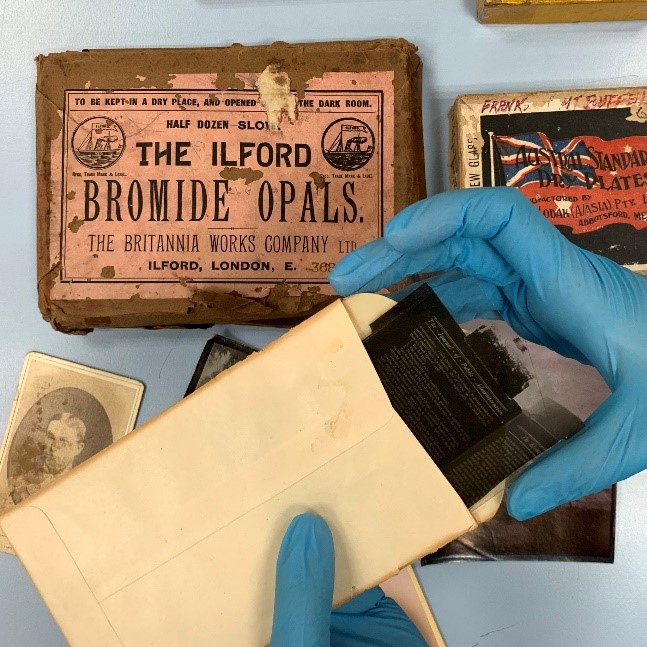
Should gloves be worn when handling rare books and collection items?
This is one of the Collection Care team’s most frequently asked questions!
While the wearing of white cotton gloves has long been synonymous with handling rare and valuable collection items, recent studies have shown they do not offer significant advantage, and in some cases can cause damage.
Libraries have changed the way they approach the handling of collection material. In fact, the use of gloves is not routinely required at State Library Victoria.
Instead, and most importantly, we ask staff and patrons to wash and dry their hands regularly.
Why not white cotton gloves?
The mandatory use of white cotton gloves is quite the misperception. As well as reducing our sense of touch and dexterity, cotton gloves can cause damage to fragile or brittle pages and transfer dirt. We have phased out cotton gloves in our reading rooms on this basis.
Why not latex or rubber gloves?
Not only are latex allergies are very common, latex and rubber can damage metals. We don’t recommend latex gloves for this reason.
When are gloves appropriate?
Of course, there are still instances when gloves should be worn. These include:
- When handling any photographic material
- When handling metals
- When handling toxic materials
- When requested during the pandemic
The type of glove will depend on the material being handled. In most cases nitrile is recommended. Staff will advise if unpowdered nitrile gloves are necessary.
Unfortunately, nitrile gloves are single use, however the majority of gloves used for handling collections at the Library are recycled through the Collection Care recycling program.
Author credit: Jane Hinwood, Conservation Manager
Hazards:
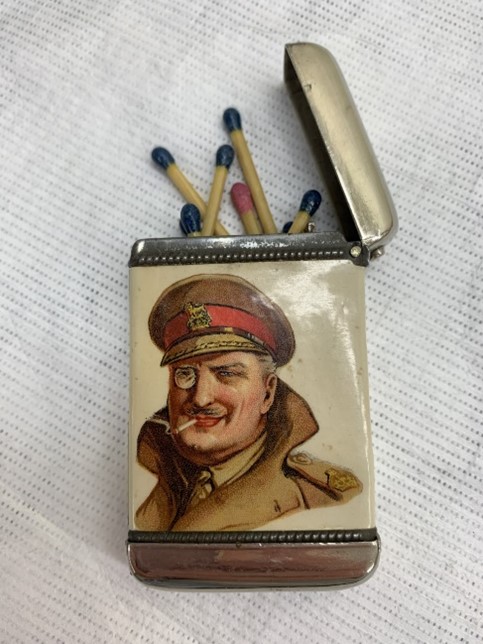

All workplaces must manage the risk of hazards that may cause injury or damage to their people and property, and State Library Victoria is no exception.
But, what about risks within the Library’s collections themselves?
Lurking in our collection could be a number of toxic substances or by-products of deterioration that may release harmful vapours.
We also have a number of sharp objects and heavy items that could cause physical injury if not approached carefully.
As well as mitigating risk in these areas, the Collection Care team are always on the lookout for:
- Arsenic, once popular to preserve feathers and skins
- Mercury, used to treat herbaria collections
- Lead, used as a base ingredient in paints
- White phosphorus, once added to the tip of a matchstick
- Pharmaceutical collections and first aid kits that may contain dangerous substances
- Deteriorating film bases that can produce toxic fumes
- Mould spores that can be inhaled or ingested
We also recognise the insidious dangers of asbestos, DDT and PDBs.
Identifying what’s in a collection, assessing the risk of potential hazards and creating safety guidelines for the handling and storage of each is crucial in keeping people (and collections) safe!
Author credit: Kate Holloway, Preservation Manager
Iron Gall Ink:

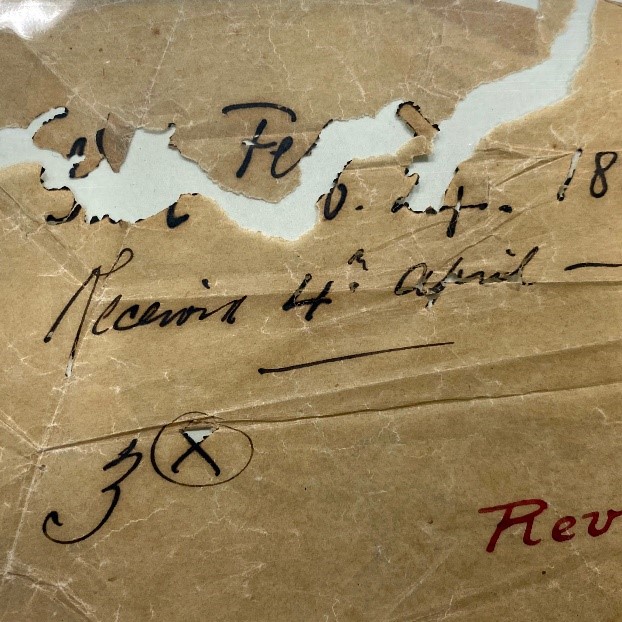
Never heard of it?
That’s exactly why State Library Victoria’s Collection Care team want to cover it!
Iron gall ink was the predominant writing ink in Western manuscripts from late antiquity right up to the 20th century. It was so prevalent in fact, it was better known as ‘common ink’.
Iron gall ink was particularly popular because it could be made at home using four basic ingredients and would etch itself into the writing support – an appealing attribute at a time when scholars feared losing their work to eager recyclers.
Ironically, these favoured properties are also what make iron gall inks so problematic.
What scholars once saw as a sign of permanence, we now know as a complicated deterioration process called ‘ink corrosion’. Most home-recipes for iron gall ink resulted in an excess of free iron (II) ions, ready and waiting to react with moisture, oxygen, and air pollutants to trigger the corrosion process.
This would see:
- The ink colour change from purple or blue-black to brown
- Areas of inked paper discolour to an intensifying brown
- Paper become brittle and crack
- Eventual disintegration, resulting in a lacework of handwriting
Unfortunately, it’s hard to know you have iron gall ink until deterioration has already begun. But do not fear, these materials can endure with careful storage and handling practices:
- Maintain stable conditions in your storage space
- Limit exposure to light, air and other contaminants by keeping your collections in archival packaging
- Restrict handling by digitising your precious items
If you suspect there is iron gall ink in your collection and are concerned about its condition, reach out to a Paper Conservator at Australian Institute for the Conservation of Cultural Material.
Author credit: Albertine Hamilton, Conservator, Paper
Japanese tools, techniques and materials

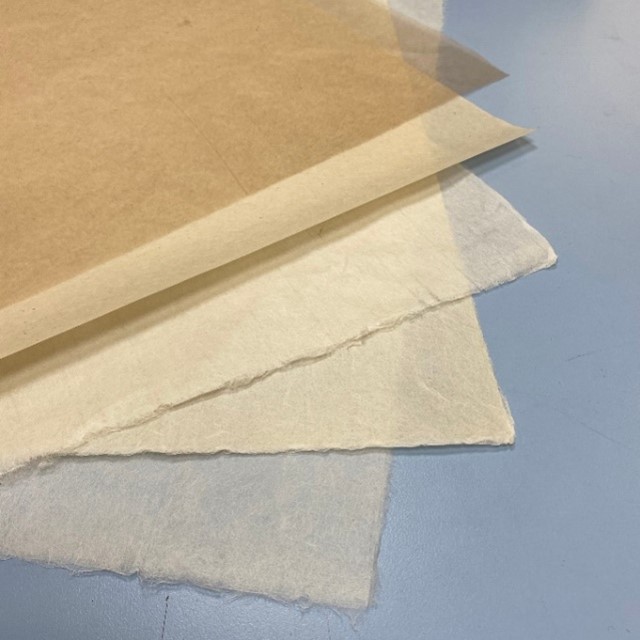
Much of contemporary paper conservation derives directly from traditional Japanese mounting tools and techniques that have been nurtured and refined over many centuries.
Cooked wheat starch paste (nori), brushes made from plant fibres and animal hair (bake), bamboo spatulas (hera), horsehair sieves (norikoshi) and paste bowls (noribon), are just a few of the materials and tools sourced.
Japanese papers (washi) utilise plant fibres such as Mulberry (kozo), a high-quality fibre renowned for its strength and longevity. The Library’s Collection Care team have a superb selection of these papers obtained from respected Japanese papermakers.
Collection Care values the generations of skill, often handed down through family lines, that are imparted within these beautifully handmade materials.
Utilisation of these long-standing traditions in conservation treatments enables the ongoing care of the Library’s wonderful collections for now and for future generations.
Author credit: Marika Kocsis, Senior Conservator, Paper
Keys:
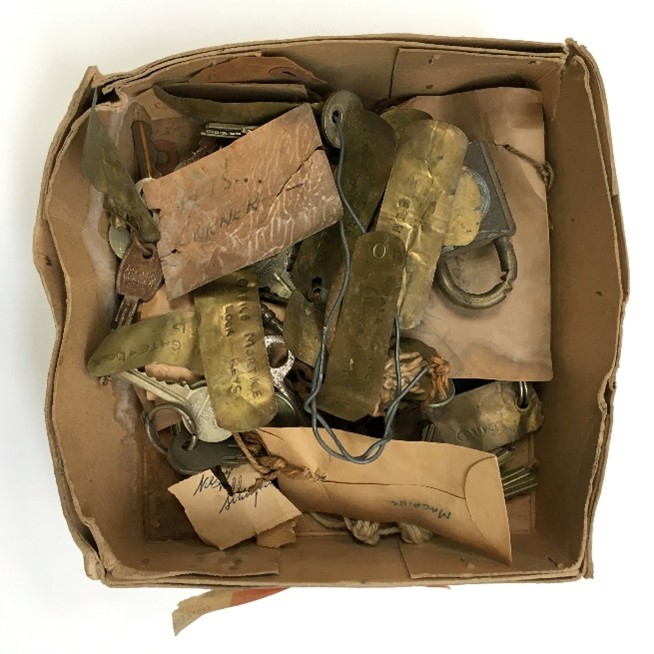
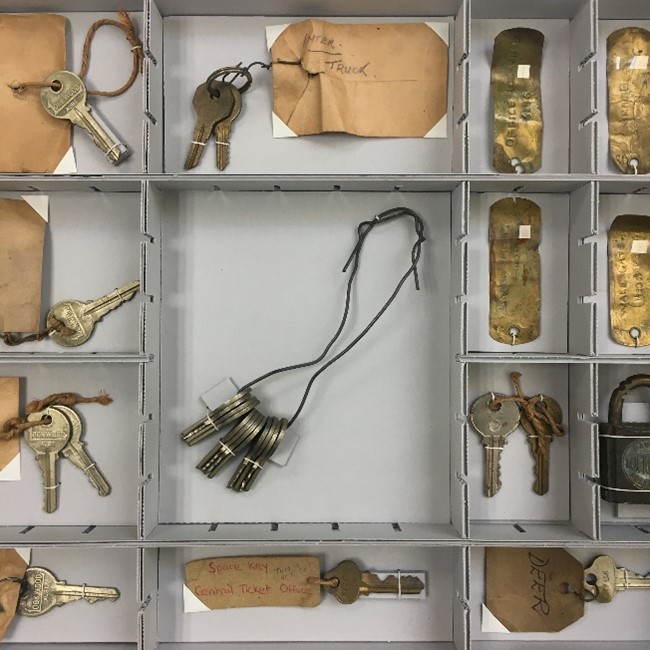
They open doors, protect treasures and unlock the unknown – but what do keys have to do with the Library’s Collection Care team?
Collection Care tends to State Library Victoria‘s rich collection of realia. This includes an array of intriguing keys – from the key that opened Captain Cook’s cottage to the heavy, jangling bundles that once provided access to the Royal Melbourne Zoo.
Keys also show up in the Collection Care toolkit. There’s the small and mighty key that our conservators use to wind George Coppin’s 19th-century standing clock, and the keys used to access special collections or restricted treatment areas such as Quarantine.
Occasionally Collection Care are even called upon to pick the locks of items that have lost their keys.
This can involve:
- Using contemporaneous keys from the Library’s collection,
- Borrowing antique keys that staff have collected over the years
- Drawing on the services of specialist heritage locksmiths.
Just like the metaphorical key, the Collection Care team are committed to keeping Victoria’s collections safe and sound, ensuring that they remain open and accessible to all.
Remar-key-ble!
Author credit: Albertine Hamilton, Conservator, Paper
Light:

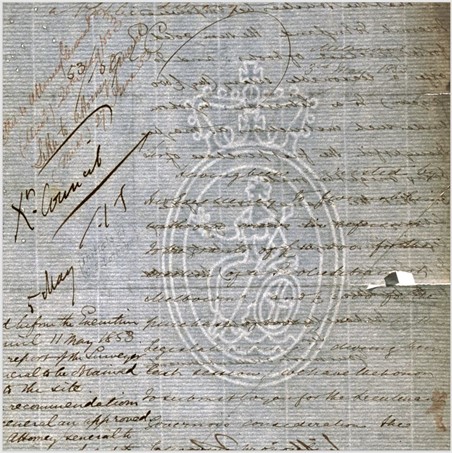
State Library Victoria’s Collection Care team have a complicated relationship with light.
Used daily to examine collection items, light is an indispensable conservation tool. Light can reveal important information about the condition of a collection item and the way it was made.
A notable example of this is a conservation technique called ‘transmitted light’, where light is directed through paper, revealing the internal structure not visible under regular lighting. This technique is often used by conservators when examining watermarks and can help to reveal if paper is handmade.
While light is essential to viewing and enjoying the Library collection, when it is not managed carefully, light can also cause cumulative and irreversible damage.
Light can cause paper to discolour and can fade or change the colour of inks and dyes. Yellowed and embrittled newspapers, darkened edges of books and faded textiles are common examples of light damage.
Cumulative light exposure needs to be carefully controlled. Ways this can be done include:
- Storing collection items in boxes when not in use
- Switching lights off when areas are unoccupied
- Controlling light levels in exhibition areas
- Managing the amount of time an artwork is on display
- Using UV filters on windows and lights
As such, it’s important to balance the need for access with the need to preserve the collection for future generations.
Author credit: Jessica McElhinney, Conservator, Paper
We hope you enjoyed part one of the Collection Care alphabet. These behind-the-scenes snapshots are really just the tip of the iceberg when it comes to caring for the Library’s extraordinary collections. Stay tuned for the next post in the series where we journey from M-Z!
Relevant links:
Find a conservator:
Disaster preparedness:
- AICCM
- Blue shield Australia
- Bushfires: Protecting your treasures
- Floods: Protect and salvage your treasures
State Library Victoria resources:
Discover more Collection Care blogs:
- A-Z of Collection Care: Part 2
- Preserving Marvellous Melbourne
- Baron Ferdinand von Mueller’s Educational Collections of Australian Plants
- Blinky Bill in the Conservation Lab
- Inside the Conservation of a 13th Century Bible
- Islamic Bookbinding
- Caring for our Collections
- The Chaos and Order of Marion Page
- Inside the Lab: Preparing for an Exhibition
- BTS of the Changing Face of Victoria


Hi, this makes for compelling reading albeit at a corporate level . Can you advise on personal heirlooms and conservation – I have inherited diary started by 2GGM in 1849, however , five generations down the track , the book is in deplorable state . How can I minimise further deterioration at modest cost ? It’s in a plastic bag atm ! Cheers !
Thanks for your question, Tim. This diary is a significant piece of your family’s history and it is fantastic that you are mindful of its longevity for future generations. The plastic bag may provide some protection in the short term, however many plastics are inherently unstable and will deteriorate and yellow over time, and have the potential to cause damage to adjacent materials. A small archival cardboard box would be a great low-cost solution to protect your diary from dust, light, pests and fluctuations in temperature and humidity, all of which can impact the longevity of paper.
We have a range of helpful conservation guides on our website covering the essentials for caring for your personal collections at home: https://www.slv.vic.gov.au/search-discover/conservation-guides.
I would also highly recommend this caring for collections video series from the State Library of Queensland. It includes loads of useful information in a fun and visually appealing format covering appropriate handling, packaging, storage, and duplication for a range of materials: https://www.youtube.com/watch?v=musEyeOgAJk
I have in my possession an old book, “London – 1843”. The pages are yellowing and the cover is falling apart but the contents are very interesting depicting the churches, advertising, zoological gardens in 1843. Would this book be of any value to the State Library?
Hi Betty, we hope you enjoyed reading the A-Z of Collection Care blog and thanks so much for your question. Comprehensive information about donating collection material to the Library can be found here: https://www.slv.vic.gov.au/get-involved/offer-collection-material-library
What a fascination insight into the activities of the “behind the scenes” team. Thank you for your dedication and congratulations to the present and past members, for the preservation of what we have the access to now and into the future.
We are so glad you enjoyed the blog! Stay tuned for Part 2…
Fantastic article Leah! Any possibility SLV might organise an event or workshop for members get advice or practical instruction in conserving their own books or manuscripts?
Hi Declan, we are so glad you enjoyed Part 1 of the A-Z of Collection Care blog! I am just one of the many Collection Care staff who contributed their wonderful knowledge and expertise to this blog. You can find author credits at the end of each section. To your question…
Members have the opportunity to join behind the scenes tours at different times throughout the year, so definitely keep an eye out for those!
We have a range of helpful guides on our website to support members to care for their collections at home: https://www.slv.vic.gov.au/search-discover/conservation-guides
If you have a specific inquiry, SLV Conservators can also be contacted via the ‘Ask a Librarian’ service, and we’ll be happy to assist: https://www.slv.vic.gov.au/interact-us/ask-librarian
The Australian Institute for the Conservation of Cultural Material Inc. (AICCM) is the professional organisation for Australian conservators. This website is a great resource for information about collection care. It includes a visual glossary of different types of damage and deterioration, as well as a directory of conservators in private practice within Australia.
I would also highly recommend this caring for collections video series from the State Library of Queensland. It includes loads of useful information in a fun and visually appealing format covering appropriate handling, packaging, storage, and duplication for a range of materials: https://www.youtube.com/watch?v=musEyeOgAJk
Hope that helps!
Leah thanks for a fantastic and informative window on your complex work. I am glad the white gloves have been phased out in the HCCR. Clean hands just before handling is less damaging. As to conservation-how-to workshops, look out for those run at RHSV periodically. None scheduled just now but they do have them.
Madonna, we are so glad you enjoyed Part 1 of the Collection Care alphabet. It was hard to stick with just one entry for each letter though! There was much discussion between the contributors, but we’re very happy with the final selection. G for Gloves was a definite though. Such an important education piece for appropriate glove usage. Thanks for sharing info about the RSHV workshops for our readers.
The complexity of book conservation is astonishing. I can no longer read because of deteriorating eyesight but am so grateful you go to great lengths to preserve material for future generations. Keep up the good work.
Agreed, Roy! Book conservation is indeed complex, and we are very lucky to have such talented book conservators on staff.
What a fabulous insight into the Library care, always wished I had taken it as a career. Loved reading the blog, many thanks to all of you for the love and care of books.
rosie
http://www.slv.vic.gov.au/legal
Rosie, we are so glad you enjoyed reading Part 1 of the Collection Care blog. Keep an eye out for Part 2… 🙂
For the term of his natural life a copy sent to the colonies. I left with the museum many years ago. Now I would like to retrieve that book. What is the procedure , would appreciate any advice thanking you rob weaver
Hi Rob,
Can you please provide a publication date and author for this volume, so I can follow up for you? Many thanks
Thank you so much for this excellent ‘snap shot’ about the conservation work at the State Library. On my (infrequent) visits to Melbourne from country Victoria, I would rate the Library as one of my favourite places to go and can happily while away hours there. I thoroughly enjoyed reading this article & will look forward to Part II. Ruth
Thank you for your generous comment Ruth. It is encouraging to know our readers are enjoying learning about the work that goes into caring for the Library’s wonderful collections. We look forward to sharing more with you soon!